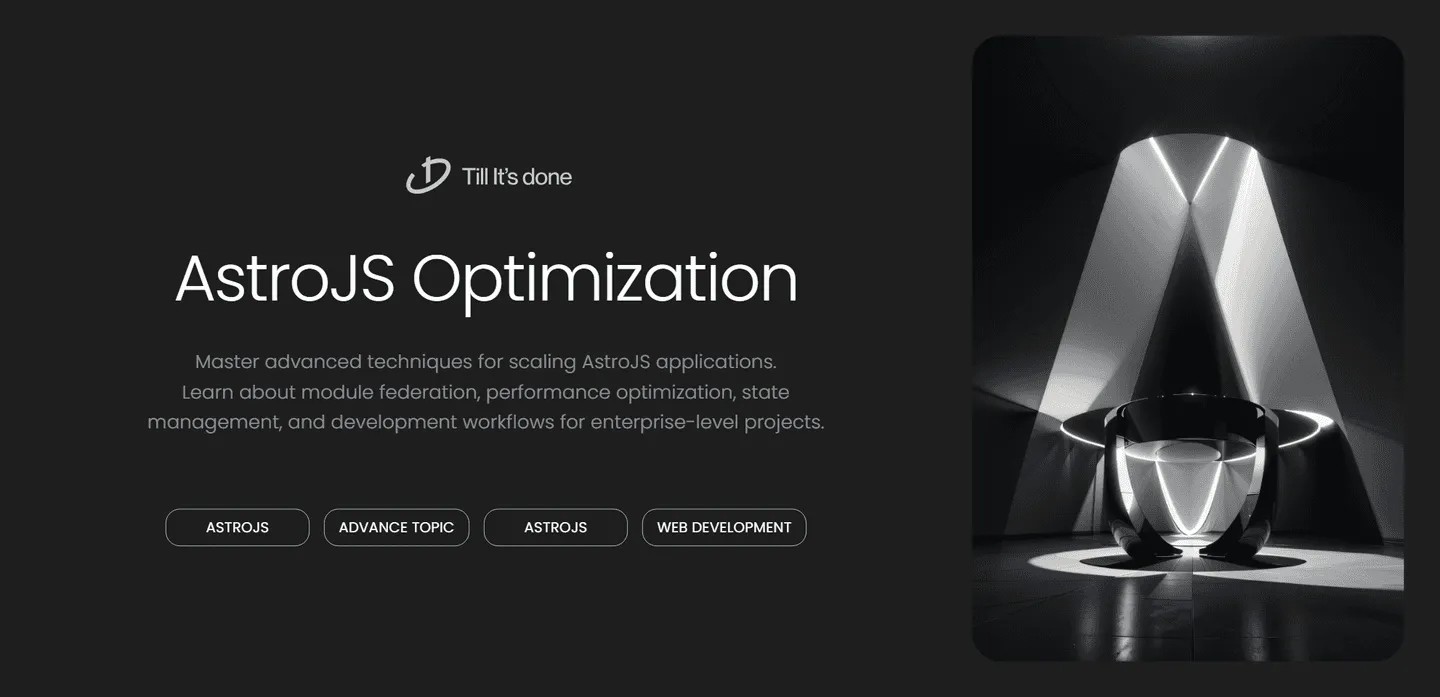- Services
- Case Studies
- Technologies
- NextJs development
- Flutter development
- NodeJs development
- ReactJs development
- About
- Contact
- Tools
- Blogs
- FAQ
Optimizing AstroJS for Large-Scale Projects
Learn about module federation, performance optimization, state management, and development workflows for enterprise-level projects.


Optimizing AstroJS for Large-Scale Projects
As web applications grow in complexity, maintaining performance and developer productivity becomes increasingly challenging. AstroJS has emerged as a powerful solution for building modern websites, but scaling it effectively requires careful consideration and strategic implementation.
Understanding AstroJS Architecture at Scale
When dealing with large-scale applications, AstroJS’s component-driven architecture becomes both a blessing and a challenge. The key is to leverage its strengths while implementing proper optimization strategies.

Module Federation and Micro-Frontends
One of the most powerful approaches for scaling AstroJS applications is implementing module federation. This pattern allows you to:
- Split your application into smaller, more manageable pieces
- Enable independent deployment of different sections
- Share components and logic across multiple applications
- Reduce build times through parallel development
Performance Optimization Strategies
1. Strategic Component Islands
Rather than implementing islands everywhere, carefully evaluate where dynamic interactivity is truly needed. Consider these patterns:
- Use static components by default
- Implement islands only for interactive elements
- Group interactive components strategically to minimize hydration costs
2. Advanced Build Optimization
To maintain fast build times in large projects:
- Leverage partial bundling
- Implement intelligent caching strategies
- Use dynamic imports judiciously
- Optimize asset loading through modern image formats and lazy loading

3. State Management at Scale
For large applications, proper state management becomes crucial:
- Implement stores only where necessary
- Use reactive primitives for better performance
- Consider using Nano Stores for cross-component state
- Maintain clear boundaries between client and server state
Development Workflow Optimization
1. Monorepo Structure
Organizing your large-scale AstroJS project in a monorepo can provide several benefits:
- Simplified dependency management
- Shared configurations and tooling
- Easier code sharing between packages
- Streamlined CI/CD pipelines
2. Testing Strategy
Implement a comprehensive testing strategy:
- Unit tests for utility functions and components
- Integration tests for critical user flows
- Performance testing for key metrics
- Automated accessibility testing
Monitoring and Maintenance
To ensure your large-scale AstroJS application remains performant:
- Implement proper error boundaries
- Set up comprehensive logging
- Monitor core web vitals
- Regular dependency audits
- Performance regression testing

Conclusion
Scaling AstroJS applications requires a thoughtful approach to architecture, performance, and development workflows. By implementing these strategies and continuously monitoring your application’s health, you can maintain high performance and developer productivity even as your project grows.
Remember that optimization is an ongoing process, and what works for one project might not work for another. Always measure the impact of your optimization efforts and adjust your strategy based on real-world data and team feedback.
 สร้างเว็บไซต์ 1 เว็บ ต้องใช้งบเท่าไหร่? เจาะลึกทุกองค์ประกอบ website development cost อยากสร้างเว็บไซต์แต่ไม่มั่นใจในเรื่องของงบประมาณ อ่านสรุปเจาะลึกตั้งแต่ดีไซน์, ฟังก์ชัน และการดูแล พร้อมตัวอย่างงบจริงจาก Till it’s done ที่แผนชัด งบไม่บานปลายแน่นอน
สร้างเว็บไซต์ 1 เว็บ ต้องใช้งบเท่าไหร่? เจาะลึกทุกองค์ประกอบ website development cost อยากสร้างเว็บไซต์แต่ไม่มั่นใจในเรื่องของงบประมาณ อ่านสรุปเจาะลึกตั้งแต่ดีไซน์, ฟังก์ชัน และการดูแล พร้อมตัวอย่างงบจริงจาก Till it’s done ที่แผนชัด งบไม่บานปลายแน่นอน  Next.js สอน 14 ขั้นตอนเบื้องต้น: สร้างโปรเจกต์แรกใน 30 นาที เริ่มต้นกับ Next.js ใน 14 ขั้นตอนเพียงแค่ 30 นาที พร้อม SSR/SSG และ API Routes ด้วยตัวอย่างโค้ดง่าย ๆ อ่านต่อเพื่อสร้างโปรเจ็กต์แรกได้ทันทีที่นี่
Next.js สอน 14 ขั้นตอนเบื้องต้น: สร้างโปรเจกต์แรกใน 30 นาที เริ่มต้นกับ Next.js ใน 14 ขั้นตอนเพียงแค่ 30 นาที พร้อม SSR/SSG และ API Routes ด้วยตัวอย่างโค้ดง่าย ๆ อ่านต่อเพื่อสร้างโปรเจ็กต์แรกได้ทันทีที่นี่  วิธีสมัคร Apple Developer Account เพื่อนำแอปขึ้น App Store ทีละขั้นตอน อยากปล่อยแอปบน App Store ระดับโลก มาอ่านคู่มือสมัคร Apple Developer Account พร้อมเคล็ดลับ TestFlight และวิธีอัปโหลดที่ง่ายในบทความเดียวนี้ได้เลย
วิธีสมัคร Apple Developer Account เพื่อนำแอปขึ้น App Store ทีละขั้นตอน อยากปล่อยแอปบน App Store ระดับโลก มาอ่านคู่มือสมัคร Apple Developer Account พร้อมเคล็ดลับ TestFlight และวิธีอัปโหลดที่ง่ายในบทความเดียวนี้ได้เลย  TypeScript Interface คืออะไร? อธิบายพร้อมวิธีใช้และข้อแตกต่างจาก Type เรียนรู้วิธีใช้ TypeScript Interface เพื่อสร้างโครงสร้างข้อมูลที่ปลอดภัยและเข้าใจง่าย พร้อมเปรียบเทียบข้อดีข้อแตกต่างกับ Type ที่คุณต้องรู้ ถูกรวมเอาไว้ในบทความนี้แล้ว
TypeScript Interface คืออะไร? อธิบายพร้อมวิธีใช้และข้อแตกต่างจาก Type เรียนรู้วิธีใช้ TypeScript Interface เพื่อสร้างโครงสร้างข้อมูลที่ปลอดภัยและเข้าใจง่าย พร้อมเปรียบเทียบข้อดีข้อแตกต่างกับ Type ที่คุณต้องรู้ ถูกรวมเอาไว้ในบทความนี้แล้ว  Material-UI (MUI) คืออะไร อยากสร้าง UI สวยงามและเป็นมืออาชีพในเวลาอันรวดเร็วใช่ไหม มาทำความรู้จักกับ Material-UI (MUI) ที่ช่วยให้คุณพัฒนาแอปพลิเคชันบน React ได้ง่ายและดูดีในทุกอุปกรณ์
Material-UI (MUI) คืออะไร อยากสร้าง UI สวยงามและเป็นมืออาชีพในเวลาอันรวดเร็วใช่ไหม มาทำความรู้จักกับ Material-UI (MUI) ที่ช่วยให้คุณพัฒนาแอปพลิเคชันบน React ได้ง่ายและดูดีในทุกอุปกรณ์  เปรียบเทียบ 3 วิธีติดตั้ง install node js บน Ubuntu: NVM vs NodeSource vs Official Repo แบบไหนดีที่สุด? เรียนรู้วิธีติดตั้ง Node.js บน Ubuntu ด้วย NVM, NodeSource หรือ Official Repo เลือกวิธีที่เหมาะกับความต้องการของคุณ พร้อมเปรียบเทียบ เพื่อการพัฒนาที่มีประสิทธิภาพ!
เปรียบเทียบ 3 วิธีติดตั้ง install node js บน Ubuntu: NVM vs NodeSource vs Official Repo แบบไหนดีที่สุด? เรียนรู้วิธีติดตั้ง Node.js บน Ubuntu ด้วย NVM, NodeSource หรือ Official Repo เลือกวิธีที่เหมาะกับความต้องการของคุณ พร้อมเปรียบเทียบ เพื่อการพัฒนาที่มีประสิทธิภาพ! Talk with CEO
We'll be right here with you every step of the way.
We'll be here, prepared to commence this promising collaboration.
Whether you're curious about features, warranties, or shopping policies, we provide comprehensive answers to assist you.


